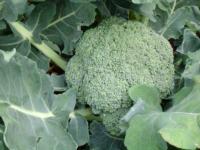Broccoli, growing
-
Broccoli is a member of the cole or cabbage family of cool-season vegetables. It matures between 60 to 90 days depending on the variety and the temperature. It is also tasty and nutritious and well worth growing in the fall-winter garden.

Soil
Well-draining soil with added compost or other amendments to increase fertility. The soil should be moist but not wet for planting.
Sun
Broccoli, as all vegetables, do best with about 6 hours of sun per day.Watering
You can use drip irrigation, a sprinkler system or water by hand. Look at and feel the soil to see if it is wet or dry. Water only if the top inch or more is dry, and then water deeply to encourage deep root growth. Keep the leaves dry by avoiding overhead watering; this helps prevent some plant diseases.Fertilizing
Fertilize your plants lightly once they have true leaves (if grown from seed) and then about every 3 to 4 weeks during the growing season. Use a balanced complete fertilizer, for example, with N-P-K numbers approximately even: 5-5-5 or 5-4-3, or similar.When to grow
Broccoli, cauliflower, brussels sprouts, and cabbage are members of the same plant family, known as the cole or cabbage family. They are hardy, cool-season vegetables, best grown when air temperatures are between 60° and 65° F. However, seeds germinate best with slightly warmer temperatures (70° F) so you can start seeds indoors if you are planting later in the season. Plant seeds or transplants in the garden between about October and February.
Read more about when to grow broccoli.
Crop Rotation
It is a good practice to rotate the planting location of broccoli and other members of the cabbage family every year to avoid disease and pest build-up in the soil. Read more about crop rotation.

